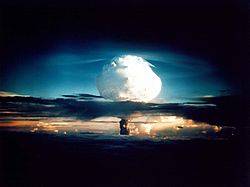Operation Ivy
| Operation Ivy | |
|---|---|

Ivy Mike
|
|
| Information | |
| Country | United States |
| Test site | Elugelab (Flora), Enewetak Atoll; Runit (Yvonne), Enewetak Atoll |
| Period | 1952 |
| Number of tests | 2 |
| Test type | dry surface, free air drop |
| Max. yield | 10.4 megatonnes of TNT (44 PJ) |
| Navigation | |
| Previous test series | Operation Tumbler–Snapper |
| Next test series | Operation Upshot–Knothole |
Operation Ivy was the eighth series of American nuclear tests, coming after Tumbler-Snapper and before Upshot–Knothole. Its purpose was to help upgrade the U.S. arsenal of nuclear weapons in response to the Soviet nuclear weapons program. The two explosions were staged in late 1952 at Eniwetok Atoll in the Pacific Proving Ground in the Marshall Islands.
The first Ivy shot, Mike, was the first successful full-scale test of a multi-megaton thermonuclear weapon ("hydrogen bomb") using the Teller-Ulam design. Unlike later thermonuclear weapons, Mike used deuterium as its fusion fuel, maintained as a liquid by an expensive and cumbersome cryogenic system. It was detonated on Elugelab Island yielding 10.4 megatons, almost 500 times the yield of the bomb dropped on Nagasaki. Eight megatons of the yield was from fast fission of the uranium tamper, creating massive amounts of radioactive fallout. The detonation left an underwater crater 6,240 ft (1.9 km) wide and 164 ft (50 m) deep where Elugelab Island had been. Following this successful test, the Mike design was weaponized as the EC-16, but it was quickly abandoned for solid-fueled designs after the success of the Castle Bravo shot.
Jimmy Priestly Robinson, age 28, a USAF captain with the 561st Fighter-Day Squadron, was lost near the end of his mission to successfully pilot his F-84G through the mushroom cloud's stem to collect radiochemical air samples. After re-emerging from the cloud, both he and his wingman Red 3 pilot Captain Bob Hagan, encountered difficulties picking up rendezvous and runway navigational beacons due to "electromagnetic after effects" of the detonation. By the time they were successful in finding the signal they were dangerously low on fuel, and before reaching the runway both had depleted their reserves. While Hagan was able to glide to the runway and achieve a hard landing, Robinson was instead too far out to follow the same path and therefore attempted to land on water, but was never found.
...
Wikipedia
